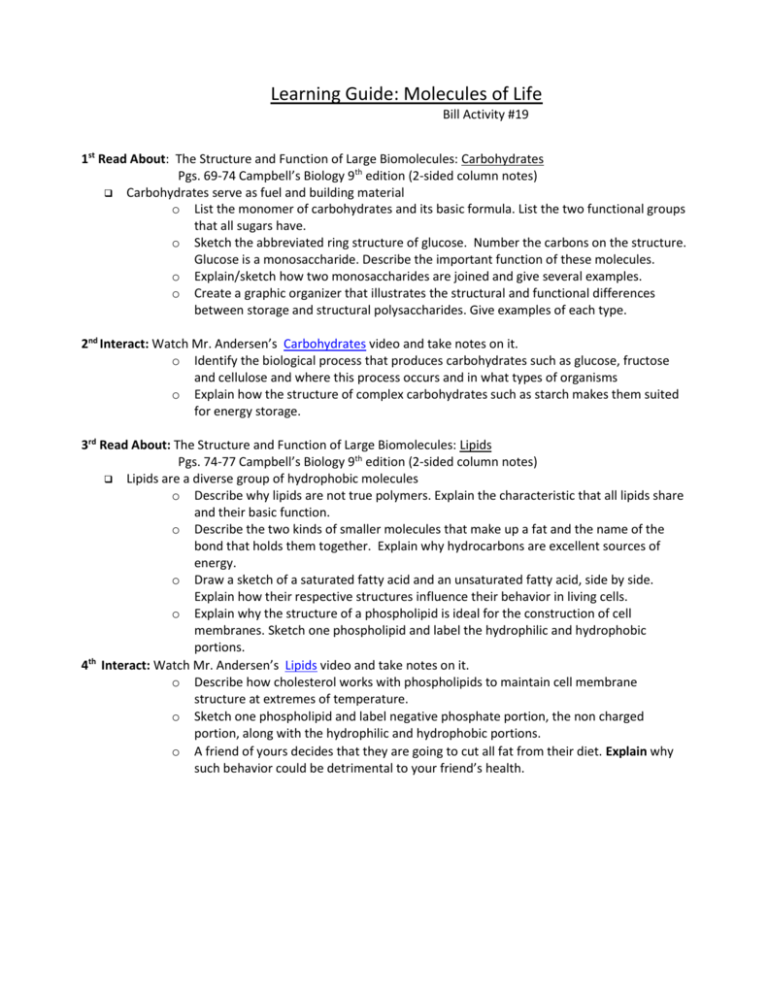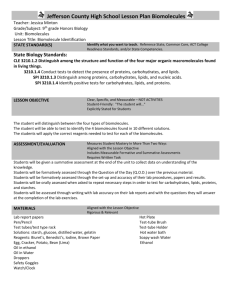BILL #19 Learning Guide Molecules of Life
advertisement

Learning Guide: Molecules of Life Bill Activity #19 1st Read About: The Structure and Function of Large Biomolecules: Carbohydrates Pgs. 69-74 Campbell’s Biology 9th edition (2-sided column notes) Carbohydrates serve as fuel and building material o List the monomer of carbohydrates and its basic formula. List the two functional groups that all sugars have. o Sketch the abbreviated ring structure of glucose. Number the carbons on the structure. Glucose is a monosaccharide. Describe the important function of these molecules. o Explain/sketch how two monosaccharides are joined and give several examples. o Create a graphic organizer that illustrates the structural and functional differences between storage and structural polysaccharides. Give examples of each type. 2nd Interact: Watch Mr. Andersen’s Carbohydrates video and take notes on it. o Identify the biological process that produces carbohydrates such as glucose, fructose and cellulose and where this process occurs and in what types of organisms o Explain how the structure of complex carbohydrates such as starch makes them suited for energy storage. 3rd Read About: The Structure and Function of Large Biomolecules: Lipids Pgs. 74-77 Campbell’s Biology 9th edition (2-sided column notes) Lipids are a diverse group of hydrophobic molecules o Describe why lipids are not true polymers. Explain the characteristic that all lipids share and their basic function. o Describe the two kinds of smaller molecules that make up a fat and the name of the bond that holds them together. Explain why hydrocarbons are excellent sources of energy. o Draw a sketch of a saturated fatty acid and an unsaturated fatty acid, side by side. Explain how their respective structures influence their behavior in living cells. o Explain why the structure of a phospholipid is ideal for the construction of cell membranes. Sketch one phospholipid and label the hydrophilic and hydrophobic portions. th 4 Interact: Watch Mr. Andersen’s Lipids video and take notes on it. o Describe how cholesterol works with phospholipids to maintain cell membrane structure at extremes of temperature. o Sketch one phospholipid and label negative phosphate portion, the non charged portion, along with the hydrophilic and hydrophobic portions. o A friend of yours decides that they are going to cut all fat from their diet. Explain why such behavior could be detrimental to your friend’s health. 5th Read About: The Structure and Function of Large Biomolecules: Proteins Pgs. 77-86 Campbell’s Biology 9th edition (2-sided column notes) Proteins include a diversity of structures, resulting in a wide range of functions. o Create a list of the many functions of proteins. Note how there is a direct relationship between a protein’s structure and its function. o Draw the generalized structure of an amino acid. Label where dehydration synthesis will occur when amino acids join together to build proteins. (Also name the bond). Explain how changing the R group changes the properties of the amino acid. o Create a 4-panel chart across two pages of your BILL to illustrate and explain the differences between the four levels of protein structure. o Describe how a change of structure will lead to a change of function as it applies to sickle cell disease. Include an explanation of why the structure changed. o Explain how the environment surrounding a protein influences its shape and structure. o Describe the role of chaperonins in the folding process. Include an explanation of what happens when proteins may be misfolded. 6th Interact: Watch Mr. Andersen’s Proteins video and take notes on it. o Explain how a 3-D protein is made. Use the terms polar, nonpolar, negative, positive in your explanation. 7th Read About: The Structure and Function of Large Biomolecules: Nucleic Acids Pgs. 86-89 Campbell’s Biology 9th edition (2-sided column notes) Nucleic acids store, transmit, and help express hereditary information o Explain the roles of DNA and RNA in making proteins. o Sketch one nucleic acid and label the three components. Explain the difference between the pyrimidines and purines; the use of deoxyribose and ribose. o Describe the overall structure of DNA . 8th Interact: Watch Mr. Andersen’s Nucleic Acids video and take notes on it. o Explain how scientists think that DNA evolved from RNA and describe the bonds that hold the DNA molecule together. 9th Interact: Watch Mr. Andersen’s Biological Molecules video and take notes on it. This is a review of all four molecules in one video. Sketch the flowcharts to help you organize the concepts. Supplementary Resources: Click the links below for more information to help you learn more about this lesson. John Kyrk: Amino Acids Learn.Genetics: DNA to Protein DNA From the Beginning: DNA and Proteins are key molecules of the cell nucleus Learn More: For more examples of biologically important molecules, use the links below: Fold it: play a game to practice folding proteins Eterna: play a game to design RNA molecules







